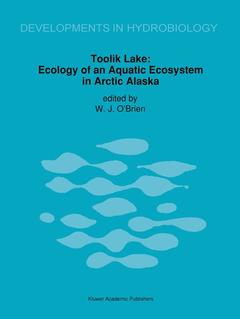Description
Toolik Lake, Softcover reprint of the original 1st ed. 1992
Ecology of an Aquatic Ecosystem in Arctic Alaska
Developments in Hydrobiology Series, Vol. 78
Coordinator: O'Brien James J.
Language: English
Publication date: 11-2012
269 p. · 19.5x26 cm · Paperback
269 p. · 19.5x26 cm · Paperback
Description
/li>Contents
/li>
The limnological study of Toolik Lake began in the Summer of 1975. This research was an outgrowth of the arctic IBP project which had focused mainly on small Arctic pond ecosystems on the Alaskan Arctic coastal plain. It was thought desirable to study larger, deeper lakes which contained fish to further generalizations developed during the IBP study.
Initial research on Toolik Lake and the surrounding lakes and ponds focused on process studies such as annual primary productivity of the lake or the vertical migration patterns of the resident zooplankton. In 1983 the philosophy of the research changed with the funding of a more integrated programme. The fundamental question posed was whether Arctic lake and stream ecosystems are regulated from the bottom up by nutrient availability or from the top down by the density and activity of top predators.
In 1987 the Toolik Lake area was designated an LTER (Long-Term Ecological Research) site, one of 18 such sites throughout the United States, Puerto Rico and the Antarctic. The research theme for the Arctic LTER also focuses on the regulation of Arctic ecosystems, whether regulation comes from the top down or bottom up. The Arctic LTER also incorporates a terrestrial component as well as a lake and stream component.
Initial research on Toolik Lake and the surrounding lakes and ponds focused on process studies such as annual primary productivity of the lake or the vertical migration patterns of the resident zooplankton. In 1983 the philosophy of the research changed with the funding of a more integrated programme. The fundamental question posed was whether Arctic lake and stream ecosystems are regulated from the bottom up by nutrient availability or from the top down by the density and activity of top predators.
In 1987 the Toolik Lake area was designated an LTER (Long-Term Ecological Research) site, one of 18 such sites throughout the United States, Puerto Rico and the Antarctic. The research theme for the Arctic LTER also focuses on the regulation of Arctic ecosystems, whether regulation comes from the top down or bottom up. The Arctic LTER also incorporates a terrestrial component as well as a lake and stream component.
The biogeochemistry and zoogeography of lakes and rivers in arctic Alaska.- Cation export from Alaskan arctic watersheds.- The flux of CO2 and CH4 from lakes and rivers in arctic Alaska.- A silicon budget for an Alaskan arctic lake.- Biogeochemistry of manganese- and iron-rich sediments in Toolik Lake, Alaska.- Nitrogen and phosphorus concentrations and export for the upper Kuparuk River on the North Slope of Alaska in 1980.- Water and sediment export of the upper Kuparuk River drainage of the North Slope of Alaska.- Influences of slimy sculpin (Cottus cognatus) predation on the rocky littoral invertebrate community in an arctic lake.- The influence of light and nutrient addition upon the sediment chemistry of iron in an arctic lake.- Epilithic diatom community response to years of P04 fertilization: Kuparuk River, Alaska (68 N Lat.).- Epilithic chlorophyll a, photosynthesis, and respiration in control and fertilized reaches of a tundra stream.- Community structure and bottom-up regulation of heterotrophic microplankton in arctic LTER lakes.- Control mechanisms of arctic lake ecosystems: a limnocorral experiment.- A comparison of slimy sculpin (Cottus cognatus) populations in arctic lakes with and without piscivorous predators.- Effects of fish predation on larval chironomid (Diptera: Chironomidae) communities in an arctic ecosystem.- Cost of predation avoidance in young-of-year lake trout (Salvelinus namaycush): growth differential in sub-optimal habitats.- Shifts in abundance and growth of slimy sculpin in response to changes in the predator population in an arctic Alaskan lake.- Salmonid diet and the size, distribution, and density of benthic invertebrates in an arctic lake.- Simulation model of the planktivorous feeding of arctic grayling: laboratory and field verification.- The effects of river fertilization on mayfly (Baetis spo) drift patterns and population density in an arctic river.- Black fly (Diptera: Simuliidae) response to phosphorus enrichment of an arctic tundra stream.- Access pipes for sampling through thick ice.
© 2024 LAVOISIER S.A.S.





